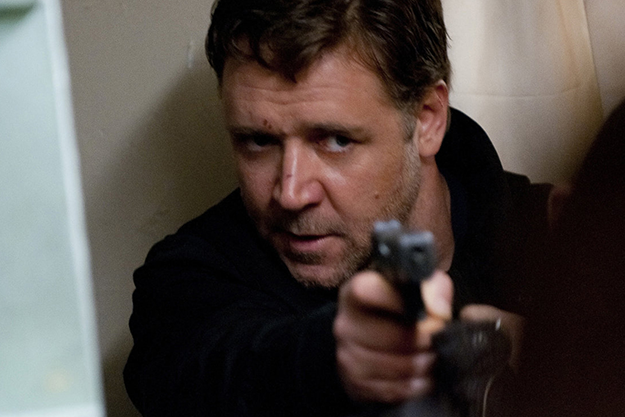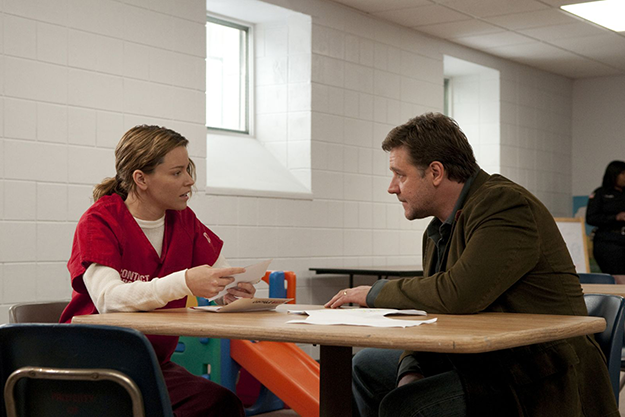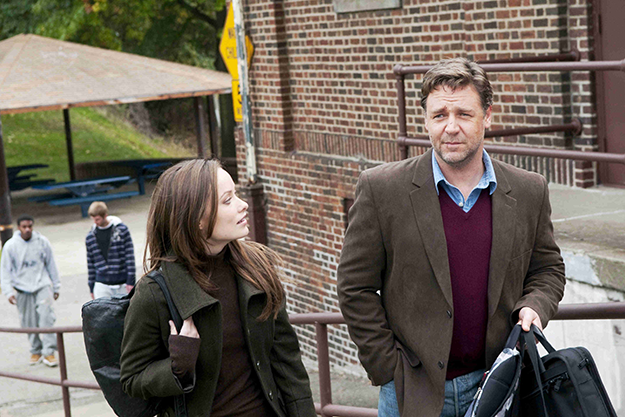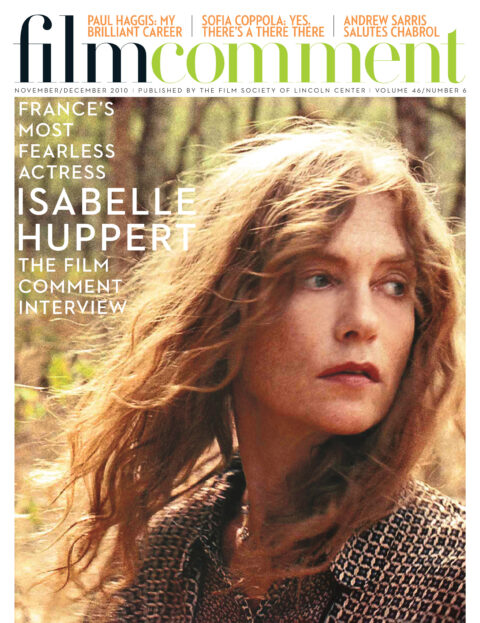
Meeting Paul Haggis on a crisp fall day in the lobby bar of the Mercer Hotel isn’t, I remind him, the first time the Oscar-winning filmmaker and I have crossed paths. That was four years ago, at a dinner party in Los Angeles, where Haggis arrived in the company of Oliver Stone and I spent most of the night thinking what a nice guy Haggis was not to confront me about my recent comments in Slate, where I had written of his eventual 2004 Best Picture winner, Crash:
Crash is an Important Film About the Times in Which We Live, which is another way of saying that it’s one of those self-congratulatory liberal jerk-off movies that rolls around every once in a while to remind us of how white people suffer too, how nobody is without his prejudices, and how, when the going gets tough, even the white supremacist cop who gets his kicks from sexually harassing innocent black motorists is capable of rising to the occasion . . . People who say that Crash is an insightful portrait of life in Los Angeles clearly don’t live in the same town I do . . . Not since Spanglish—which, alas, wasn’t that long ago—has a movie been so chock-a-block with risible minority caricatures or done such a handy job of sanctioning the very stereotypes it ostensibly debunks. Welcome to the best movie of the year for people who like to say, “A lot of my best friends are black.”
That article was quickly rebutted by Roger Ebert in the Chicago Sun-Times, under the headline “In defense of the year’s ‘worst movie,’” before I penned a final riposte of my own in the pages of the LA Weekly—collectively, it would seem, a lot of critical hot air, since Haggis claims never to have read a word of it. Or perhaps that’s just his good-natured Canadian politesse talking. For Haggis is Canadian-born, even though he’s now spent more than half of his 57 years as an American—long enough, he says, for him to include himself when he says things like “I’m fascinated by the way that we, as Americans, judge others, and the way that we do so with such arrogance.”
“I think the moment I became an American I took on all of America’s sins,” he adds with a chuckle, “and exemplified most of them.”
Though I wouldn’t retract a word of the above—or the feeling that Haggis’s next feature, In the Valley of Elah (07), was proceeding just fine until the moment when the Tommy Lee Jones character, a retired military policeman investigating the suspicious death of his Iraq vet son, discovers that everything he holds true about his country is a lie and responds by raising an American flag upside down—I have been and remain a great fan of Haggis the screenwriter, whose credits include a handful of the best and best-written Hollywood films of the last decade. Among them: Clint Eastwood’s Million Dollar Baby (04), Flags of Our Fathers (06) and Letters From Iwo Jima (06), and the exhilarating James Bond reboot Casino Royale (06).

Now, Haggis is back with his fourth directorial effort, The Next Three Days, starring Russell Crowe as a mild-mannered community college professor who finds himself masterminding an elaborate prison break after his wife (Elizabeth Banks) is convicted of bludgeoning her boss to death. Adapted from the 2008 French movie Pour Elle (with Vincent Lindon and Diane Kruger in the lead roles), it’s a slow-burning (and decidedly non-political) suspense film, leading to a long, twisty payoff through the highways and byways of western Pennsylvania. And if it risks sounding like a backhanded compliment to say that I consider it the best thing Haggis has yet done as a director, let me add that The Next Three Days is that rare “psychological thriller” with a genuine emphasis on the psychological—specifically, on the toll taken by the theft, forgery, and even murder that Crowe’s ordinary husband/father justifies to himself in the name of “saving” his wife (who may or may not be innocent).
“The question I wanted to ask is: would you save the woman you loved if you knew that by doing so you would turn into someone that she might never be able to love again?” says Haggis, who added complexities and complications to what he deemed the too-tidy narrative of his source material, including a third-act crisis in which Crowe and Banks must weigh their own freedom against their love for their 6-year-old son. “I was also really interested in the idea of how I would go about something like this,” he adds. “I mean, how would a common man who has no idea how to break someone out of jail—it’s not Clint Eastwood breaking out of jail, it’s not a hardened criminal, it’s someone who teaches literature, who has a very romantic notion of what a jailbreak is. He thinks, Oh yes, I can do this. I can become that romantic hero who saves his wife. But that has nothing to do with reality. When people start dying, one of the people who dies is someone who turns out to be not that bad, and it’s his fault. He slowly starts to pay with his soul for this thing he’s doing.”
Of his decision to shoot The Next Three Days in Pittsburgh, which becomes a vivid character in the story (Crowe at one point dodges police by disappearing into a crowd of rabid Penguins fans), Haggis says he “wanted a working-class city that had evolved. I wanted him to come from working-class stock, and for his parents to still be living in that old clapboard house, and for his father to be the strong silent type who would have formed him, but he went off and became a teacher, got an education, and his father was very proud that he got that education but is still judging whether he’s a man or not, because he’s not a steel worker.”
Haggis’s own father ran a construction company in London, Ontario, where the young Paul grew up loving movies but not knowing how to make a career out of them. After an ill-fated sojourn in London, England, where the twentysomething Haggis, deeply under the influence of Antonioni’s Blow-Up, tried his luck at becoming a fashion photographer, he returned home and worked in the small community theater his father had built as a gift to Haggis’s sister, an aspiring actress. “I was sort of the stage manager, and then I started a film society there,” says Haggis. “We didn’t really get many foreign films there, or classic films. I’d never seen Bergman films, I’d never seen Pasolini, Godard or any of these films. So I started booking them, 16mm prints. I’d strike the set on Saturday night, have a Saturday midnight show and two on Sunday.”
Finally, in the late Seventies, he relocated to Los Angeles, where he worked a series of odd jobs before finally breaking into the world of episodic television, earning writing credits on the likes of The Love Boat, The Facts of Life, and that landmark Eighties social-issue sitcom Diff’rent Strokes, a precursor to Crash if ever there was one. By the late Eighties, Haggis had advanced to hourlong dramas like Thirtysomething and L.A. Law, and to creating his own series, most of which suffered the common network television fate of being hailed by critics and ignored by audiences, the notable exception being the Chuck Norris vehicle Walker, Texas Ranger (93-01). “The more commercial my shows were and the longer they lasted, the less happy I was,” Haggis says. “I really loved the ones that failed. If something didn’t get past the pilot script, it was usually because I really loved it.”
Of those Haggis shows that did make it to air, however briefly, he is particularly fond of EZ Streets (96-97), a sprawling, multi-character urban drama starring Ken Olin as a possibly dirty cop trying to bring down the mob boss (Joe Pantoliano) possibly responsible for the death of Olin’s partner. And that is but the tip of a systemically corrupt iceberg that reaches deeper than Haggis had a chance to reveal during the show’s nine-episode run.
As Haggis tells it, “I wanted to do a television show that said, I’m going to show you the good guy, I’m going to show you the bad guy, and I’m going to make you hate the bad guy and love the good guy. Now watch this: you’re about to love the bad guy and hate the good guy. Now you know what’s what. Oh yeah? Watch this: you’re about to love the good guy again and hate the bad guy again. And to just keep doing that over and over again, so we see how complex human beings truly are.”
That same strategy—sometimes bluntly effective, sometimes simply blunt—can be seen as the driving force behind many of Haggis’s subsequent projects, from the Iwo Jima diptych (with its candid depiction of heroism and savagery on both sides of the “good war”) to Crash and its panorama of intolerance across all races, creeds, and colors.

“I didn’t actually ever know if it was a good movie or not, and I still don’t,” he says of Crash when we arrive back at the subject. “I didn’t know if it was a good screenplay when we finished it. I didn’t know when I came up with the story if it was a good story. What I knew is that it was, for me, a good social experiment. I wanted to fuck with people, because I was so angry. Eighty percent of those stories are things that I had experienced in Los Angeles, that I had seen with my own eyes. and the hypocrisy of it, of the liberals, who all tried to deny that this was going on. “Some people have said, ‘Well, it’s all stereotypes.’ And I say, ‘Yes, that’s exactly what it is.’ When I was thinking about how to approach it, I thought, Okay, I want the lights to go down, I want you to sit in the dark, and I want you to be comfortable. In order to do that, I’m going to reinforce everything you think about other people—secretly think, because you’re a liberal and you can never admit to this shit. So, I’m going to go, ‘Shh, it’s okay. We all know they park their cars in their lawns. You can laugh. You’re in the dark. Nobody’s looking. I’m not going to challenge you.’ So, I let you sit back and relax and judge the people, because they’re all stereotypes—they’re doing exactly the things that you know in your heart they actually do. And as soon as I have you really relaxed, then I can fuck with you. It’s hard for me to live with being tagged as someone who writes stereotypes, because I’d never done it before, and everything I’ve written since, even though I have strongly political feelings, has very nuanced characters. But I did it on purpose, and if people didn’t get it, I didn’t give a shit. I wanted it to have an impact, and it did.”
Asking himself questions for which he doesn’t know the answers is, Haggis says, his preferred mode of attack for any script. “With In the Valley of Elah, I didn’t have a movie until I asked myself, Well, Mr. Big Liberal, what would you do if you were in a jeep driving down the street and you were told that if anyone gets in front of you, you should run them over, because it’s not just you whose life is in danger here. If there’s an ambush, it’s you, your buddy, and the six guys behind you. Worse than that, if you stop, you block the road, it’s the six vehicles in the convoy behind yours. These shitheads can pop up and kill all your friends. So, make a choice now: a kid runs out in the road right in front of you. Do you stop or not? Choose the kid or choose your buddies. You’re 17, 18 years old, you’ve got three seconds, do it now! I couldn’t make that decision, and how old am I?”
And Haggis’s process remains very much the same even on a micromanaged blockbuster like Casino Royale, which offered the most human and vulnerable 007 since George Lazenby wept over the body of his assassinated bride in the final frames of 1969’s On Her Majesty’s Secret Service. “I thought they were idiots to bring Casino Royale to me, but I loved the idea of taking that character and really investigating him, asking the same questions of Bond you would ask of anybody else,” he says. “What’s it truly like to be an assassin? I don’t believe you shoot a laser at somebody from the moon and laugh and say a funny line. That’s not an assassin to me. I think when you kill a man it’s usually with a knife, you get blood on your hands, and you get blood on your soul—and no matter how much you say it doesn’t bother you, it will haunt you forever. That’s what I wanted to show. It was great fun to do that. The next one [2008’s Quantum of Solace], not so much.”
“In L.A., nobody touches you,” intones Don Cheadle’s LAPD detective under the opening credits of Crash, unsubtly proffering the movie’s thesis. “We’re always behind this metal and glass. I think we miss that touch so much, that we crash into each other, just so we can feel something.” A recent transplant to New York, Haggis seems pleased to be free of that metal and glass prison—as well as from the Church of Scientology, which he left after 35 years of membership following a damning letter to Church leader David Miscavige, widely circulated online, in which Haggis blasted the organization for a litany of civil rights abuses. When I ask if any of this entered into his decision to make a movie about a family on the run, Haggis says, “I actually didn’t give it any thought. I wish I had. It would make a much more interesting story. It’s a good question.”
As for his new East Coast life, Haggis says he’s happiest about the certain degree of anonymity it affords him. “I have one or two really good friends in the city and the rest are acquaintances, and I sort of like it that way. It’s almost a lonely existence in the middle of all these people, and it’s the way I write as well. I’ll sit where you’re sitting right now and I’ll write, and no one will bother me, but I’ll hear life all around me, and I’ll fool myself into thinking I’m a part of it. That’s what New York is like to me. I fool myself into thinking I’m in contact with other human beings, but I’m not. I’m just brushing past them on the way to work.”








